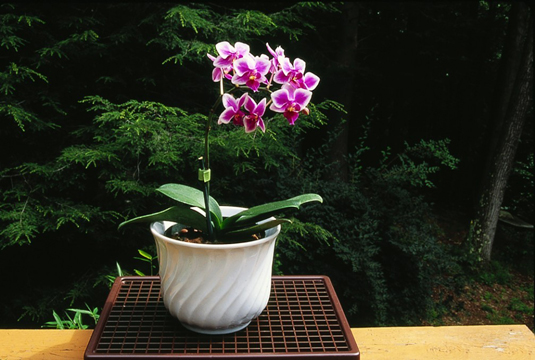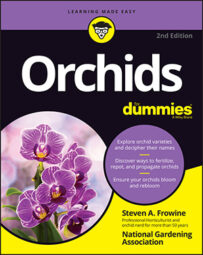Insufficient humidity can stunt an orchid's growth and, in severe cases, it can cause brown tips on leaves. It can also contribute to orchid buds falling off (known as bud blast), leaves wrinkling, and drying of the sheaths (the tubelike structures that surround the developing flower buds), which can result in twisted or malformed flowers.
During the winter, homes, especially those in cold climates with forced-air heating systems, usually have a relative humidity of about 15 percent. Because this is the average humidity found in most desert areas, you have to do something to raise the humidity to at least 50 percent — a level that will make orchids happy.
High humidity levels that would be no problem in a greenhouse will peel the paint, plaster, and wallpaper off the walls of your house. Assuming that's not the look you're going for, you can take several steps to get to the desirable humidity range without causing damage to your house.
If you can, put your orchids in a naturally damp area, like the basement.
Wherever you put your orchids, use a room humidifier. An evaporative-pad humidifier is usually better than a mist humidifier, because, unlike a mist humidifier, it doesn't leave your orchids with a white film (from the minerals in the water being deposited on the leaves).
To further increase the humidity level, you can try growing the plants on top of a waterproof tray filled with pebbles. Add water to the tray so that the level is just below the surface of the pebbles, then put the plants on top of this bed of damp gravel. The problem with this system is that the pots, especially the heavy clay ones, frequently sink into the pebbles, resulting in the media in the pots getting soggy and, after repeated waterings, the pebbles becoming clogged with algae and being a repository for insects and various disease organisms.
The best approach is to add sections of egg-crate louvers (sold in home-supply stores for diffusing fluorescent lights) to the trays). You can cut this material with a hacksaw to whatever size you need. It's rigid so it will support the plants above the water, and the water is more exposed to air, so more humidity results. The grating is simple to clean — just remove and spray it with warm water. To prevent algae or disease buildup, you can add a disinfectant like Physan to the water in the trays.

Misting is another way to increase humidity. This works okay, but to be effective, you need to do it several times a day, because the water usually evaporates very quickly. A problem with misting is that, if your water source is mineral-laden, your orchid's leaves may become encrusted in white — not only is this unsightly, but it keeps light from penetrating to the leaves. Use distilled water, if you can. A benefit to misting is that it can clean the dust from the leaves.

